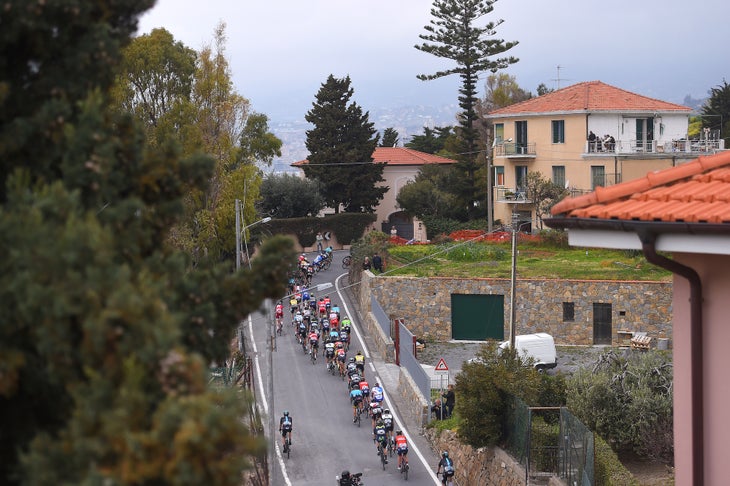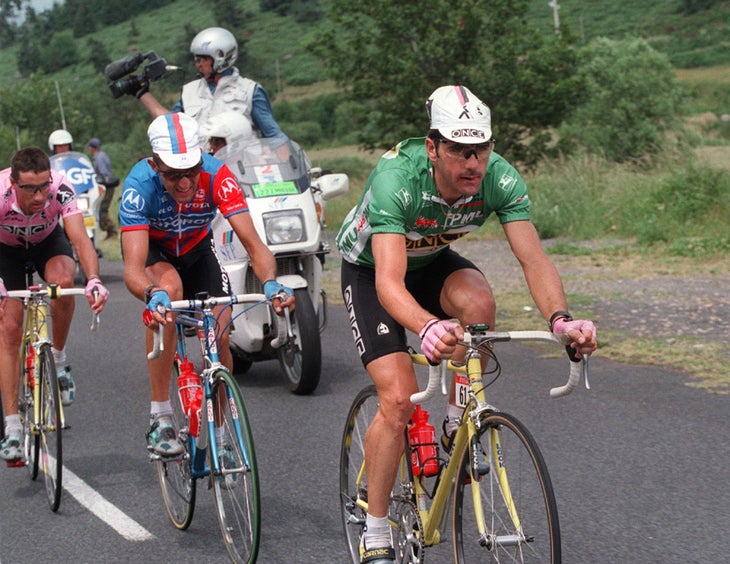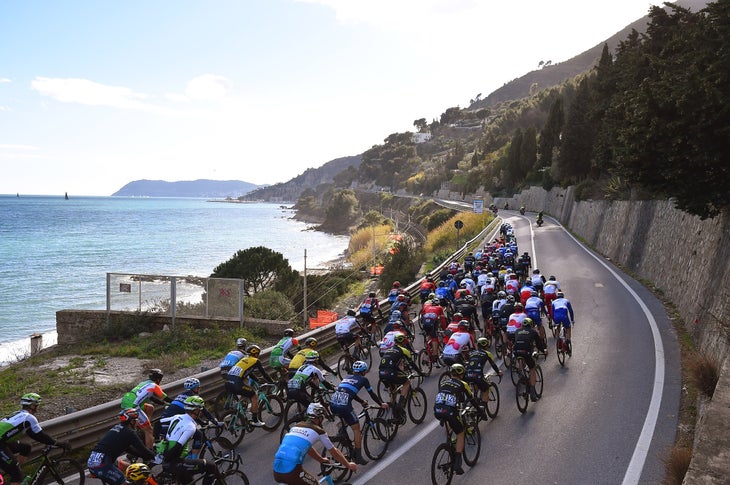Heading out the door? Read this article on the new Outside+ app available now on iOS devices for members! Download the app.
Frenchman Laurent Jalabert won a lot of bike races back in the day. After all, he was the world’s number-one ranked rider for four years back in the 1990s.
But when “Jaja” looks back on his career, one race stood out—the 1995 Milano-Sanremo. In many ways that is where it all started for Jalabert. That is when he won his first monument and started his long reign at the summit of the world ranking. And in the absence of what would have been the 25th anniversary of the victory on Saturday, VeloNews caught up with Jalabert to look back at his memorable victory and reflect on life without La Primavera, as professional cycling, like all aspects of society, struggles to contain the coronavirus crisis.
VeloNews: Laurent, it’s hard to believe that 25 years have passed since you won Milano-Sanremo!
Laurent Jalabert: Oh yeah, boy does the time go by quickly!
VN: What stands out when you think back on that historic win today?
LJ: It was the most beautiful day of my career! And I say that for several reasons. I was in a great phase, just off of my victory in Paris-Nice, which really gave me confidence going into Milano-Sanremo. I came into the race as a real favorite along with Maurizio Fondriest, who had just won Tirreno-Adriatico. We were the two big favorites. And I don’t know why but I was just convinced that the race this year was for me.
I just went into the race with great confidence. Already the night before, when I got my number, I saw it was number 44. And four was always my lucky number it seemed. At the time I had four children and I had won lots of races with a four on it. So to have 44 was like I was double lucky! And when the director sportif gave me number 44 I just laughed. Destiny just seemed to be with me!
Now Milano-Sanremo was always a race I had dreamed of winning, so after Paris-Nice I stayed down on the Côte d’Azur to ride along the roads down there and avoid extra travel. We trained there until Thursday when I met up with the team and we did the recon of the final kilometers of the race. Now 25 years ago there were not a lot of teams that did this, but I really needed to get the Poggio in my head. I remember I climbed it three or four times that day so I had a really good sense of how to position myself 48 hours later. I looked for the best spot where I could attack, and hopefully get a gap before the summit. I remember marking this one spot where there was a sewage grate in the middle of the road. It came after we passed the chapel that marks the end of the steepest part of the climb. There is a short flat section after the chapel before the road climbs again and I said to myself that when we hit that sewage grate I would attack.

VN: And things happened like that?
LJ: Almost! I remember when we the Poggio very fast and I found myself on Fondriest’s wheel coming out of the first turn. I didn’t look for his wheel per se, it just happened that way. And I stayed on his wheel until the moment when he attacked, which by chance, was only five or 10 meters before the sewage grate. I just followed him, but boy was he killing me! It was everything I could do to hold his wheel. At one point I thought I was going to blow up, but I pushed through and we hit the descent with five or six seconds advantage.
After that point my biggest fear was getting down the descent without a problem. I was pretty much convinced that, when I made it over the summit with just two of us, victory was mine. But I was really scared of flatting or crashing on the descent. The descent of the Poggio is very technical and dangerous. And when you hit the descent of the Poggio you are not very lucid. You are in the red from the climb and you really have to know the descent. You have to know the turns. And Fondriest knew it really well. He actually led most of way. I’ll never forget, the moto for Italian TV was right on my wheel in the descent. I was so scared that it would crash into us.
But once we hit the bottom we only had a kilometer and a half before the finish. Now I can be pretty stressed in general, but once we hit the bottom I was just sure that I would win. I don’t know why. After all, Fondriest had already won the race just two years ago. But I was really confident of my chances.
VN: Well on paper you were definitely the fastest. And you won handily really!
LJ: Well I said that I needed to sprint 200 meters from the line and I probably went even earlier. But that day I had a 52 x 11 [gear ratio]. That was the first time I had ever used an 11 in a classic. And I think I was one of the first. When we hit the line, Fondriest threw out his arms [in despair] but I don’t think he understood that I had an 11. He had a 52 x 12 and he was going as hard as he could and did not understand how I rode away from him. But I had a bigger gear! He was leading out and was looking behind and then looking in front of him, behind and then in front. I jumped just when he looked back in front. I jumped in the 52 x 12 and then shifted into my 11.

VN: It’s interesting because although your team ONCE was very strong, in the final you were very much alone.
LJ: Yes but that was a real choice we had made. We decided to ride hard from the beginning. I had a really good team, and they all rode for me that day. But we wanted to make sure that there would not be a sprint and we knew that the only way to do that was by riding hard from the first kilometer. There was an early break but we kept the pressure on.
VN: At the time the race rarely finished in a sprint.
LJ: No that’s true. The race almost always came down to a few riders. It was only a couple of years later that the sprinters realized that they could really make it over the Poggio and their teams started riding to keep the race together for a sprint, well no breakaways got away on the Poggio for many years.
VN: It was your first victory in a big classic, a Monument. What did it mean for you to finally win Milano-Sanremo?
LJ: In some ways I had the impression to be living a dream. I had always dreamed of winning Sanremo and I had said to myself that if I wanted to leave my mark on the history of cycling, I had to win Sanremo. But it totally blew me away. I didn’t sleep all night. And when I woke up and had to go to the newsstand and buy all of the newspapers to see what they said and make sure it really happened.
But then strangely, once I finally won it, it kind of lost some of its esteem. It had been this unattainable thing for so long. And when I won it it was like, “Oh that wasn’t so complicated!” But I can tell you today, 25 years later, when people ask me what were my greatest memories, well, Milano-Sanremo was my greatest. It was the most beautiful!
VN: Well Sanremo is like that. It wasn’t the only monument that you won. You also won the Tour of Lombardy. But there is just something about Sanremo. Lombardy is a beautiful race, but it comes at the end of the season. Milano-Sanremo is the first monument of the season and it really leaves an impression.
LJ: Yeah that’s it. I would never say Lombardy is easy to win. But there are less riders in good shape at the end of the season and if you still are in good condition, it is easier.
VN: And when you won Lombardy there were a lot of tactics involved. Michele Bartoli was in the breakaway with you and at the time. He wanted to assure the overall World Cup title [a special award based on overall points in the best one-day races], so he did a lot of work in the break. In Sanremo it was just you and Fondriest, both at the height of your game. It was real mano-a-mano, pure sport! And then there is the race course itself that rolls all along the Mediterranean coast. It’s just gorgeous.
LJ: Yeah it is just such a beautiful race. But it is also such a stressful race. For 300 kilometers the stress just intensifies and when you approach the final climbs, there is just a huge sprint for each. To win you have to make it through all that stress.
And then that year, the fact that it was just Maurizio and myself in the final was special. Fondriest was just one of those riders who made me better, who pushed me to my limits, to some of my greatest victories, be it in Milano-Sanremo or the Flèche-Wallonne.

VN: I imagine that you watch Milano-Sanremo every year. Has it changed?
LJ: Well the Poggio is still the same. The place to attack has not changed. You go into the red zone in that first section as you make the climb up to the chapel. Then there is the flat section where the strongest can attack, while others can’t. The difference is that more and more teams have a sprinter that can eventually make it to the line. Back when I raced Milano-Sanremo, it was a race for the punchers. But today it is almost a race for the sprinters.
VN: That said, a lot of guys have gotten away and stayed away in recent years. Michal Kwiatkowski, Vincenzo Nibali and Julian Alaphilippe all got away on the Poggio.
LJ: That is true. The punchers still have their chance.
VN: And the winner that has most impressed you since you won?
LJ: Hmm, that’s hard to say, but I guess Nibali. His victory was just so unexpected. He is not a sprinter and not a real puncher. He doesn’t fit the mold of a Milano-Sanremo winner, and yet he went out and did it!
VN: It must be very strange for you learning that Milano-Sanremo is not being held in March for the first time since World War Two?
LJ: It’s definitely frustrating for me, for the sport of cycling, for everyone really. But the fact that Sanremo, like every other bicycle race or sporting event is canceled or postponed is just a testament to the gravity of the situation. And it is a very clear reminder to all of us. When things like this happen in far away places it is easy to ignore, but what is happening now simply demonstrates that no one is free from the current crisis. And it is so important that we have no choice but to put everything on hold until we get past this.
VN: While it has been years since you raced, you are clearly still very fit and have done numerous marathons and triathlons.
LJ: Oh yeah! Working out is still very important to me. Right now, I would say that competing is not such a priority, but staying healthy and fit still is still really important to me and I average 15 hours a week of running and cycling. Obviously that is not going to be easy to do given the current situation, but that is what I try to maintain in normal times.